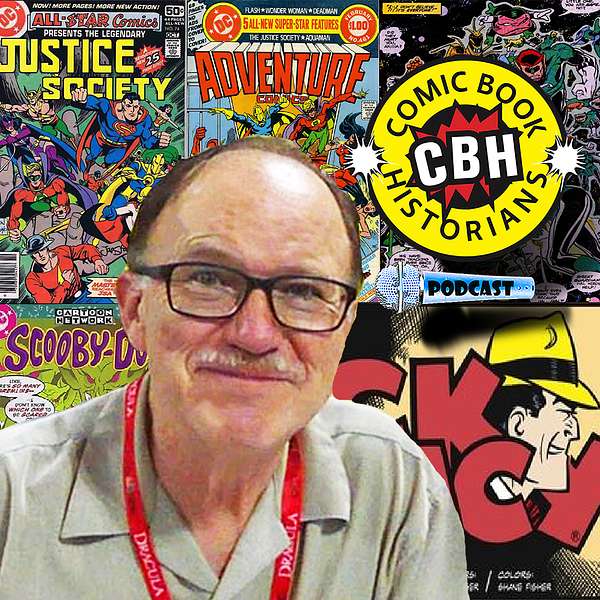
Comic Book Historians
As featured on LEGO.com, Marvel.com, Slugfest, NPR, Wall Street Journal and the Today Show, host & series producer Alex Grand, author of the best seller, Understanding Superhero Comic Books (with various co-hosts Bill Field, David Armstrong, N. Scott Robinson, Ph.D., Jim Thompson) and guests engage in a Journalistic Comic Book Historical discussion between professionals, historians and scholars in determining what happened and when in comics, from strips and pulps to the platinum age comic book, through golden, silver, bronze and then toward modern
Support us at https://www.patreon.com/comicbookhistorians.
Read Alex Grand's Understanding Superhero Comic Books published by McFarland & Company here at: https://a.co/d/2PlsODN
Series directed, produced & edited by Alex Grand
All episodes ©Comic Book Historians LLC.
Comic Book Historians
Joe Staton Career Interview: Detective Comic Artist part 2 with Alex Grand & Jim Thompson
Alex Grand and co-host Jim Thompson interview comic artist, Joe Staton in a second of a 2 parter discussing his DC Career with All Star Comics, The Justice Society of America, Earth 2 Superheroes, Green Lantern, Omega Men, collaborations with Paul Levitz & Marv Wolfman, conflict with Sol Harrison, his art director career with First Comics working with guys like Mike Gold and Howard Chaykin, over 100 issues of Scooby Doo comics, and his current Harvey Award winning project with the Dick Tracy comic strip. Edited & Produced by Alex Grand. Images used in artwork ©Their Respective Copyright holders, CBH Podcast ©Comic Book Historians. Thumbnail Artwork ©Comic Book Historians.
Jim: 1976 or so, you finally got some work at DC. Specifically, Paul Levitz brought you in to do some inking on Karate Kid over Ric Estrada’s pencils. Is that right?
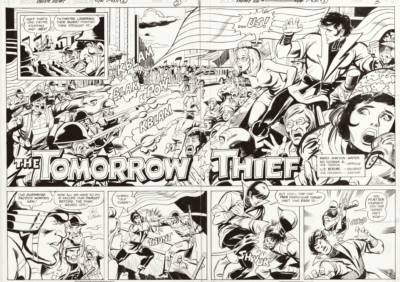
Staton: That’s right. It’s just like everything else, a call out of the blue, from Paul. It’s amazing to think how young he must have been at those days. He wanted to know if I’d like to do some work for DC. I was a little stifled at Marvel, I thought at the time, with just getting, mostly inking. So I was, I guess, going to do some finishes for DC.
Jim: DC actually, relatively quickly, let you start doing pencils as well… And they were on, not the main comics, but on things that were coming back or they were trying to give them another chance. When you started doing pencils, Joe, it seemed like you were being given assignments that were like fan favorites, but not necessarily, the big heroes. You were doing Metal Men, and then you got to revitalize Doom Patrol over in Showcase, and then on its own title. Right?
Staton: Right. And a lot of that I was doing my own pencils and my own inks. Which was a real attraction at the time, because it’s what I’d been doing at Charlton.
Jim: Were those comics that you had followed when you were younger, did you have any attachment to those characters?
Staton: Well, I definitely had an attachment to the Metal Men because I was a big fan of Andru and Esposito. I loved what they did. I really didn’t know much about the Doom Patrol. That was just because Paul Kupperberg and I work, kind of in the office with Paul Levitz one day, and he says, “We’re doing the Doom Patrol. You want to do that?” I kind of said, “What’s that?” And we did it. It was kind of lucid those days, if you were in the office, you wound up doing something
Jim: Then at some point, you were moved up to bigger heroes. You did Superboy, but you also did Wonder Woman. This is in the late ’70s. And you got to do Green Lantern, which must have been exciting for you because of the Gil Kane connection.
Staton: All right, and I was a big Green Lantern fan, ever since Gil… Since Green Lantern had come back on Showcase. So, I’d been, kind of, putting my name in for Green Lantern whenever there would be a chance. Eventually, Jack Harris was the editor, and Jack and I were buddies, and he put me in to take over Green Lantern.
Jim: In that run you were doing with Roy Thomas some, and Marv Wolfman some, is that correct?
Advertisement
Staton: No. Never with Roy.
Jim: He got some credits for it, but it’s story credits, I guess.
Staton: Oh, okay. I didn’t know that, or I lost it. [chuckle] But, I started at the very end of Denny O’Neill’s run. I did the story where Green Lantern and Green Arrow broke up, and they weren’t traveling buddies anymore. And then after that, I had a run with Marv Wolfman. So that was my first time out on Green Lantern.
Jim: Was this after Mike Grell had done? He had been doing some Green Lantern, Green Arrow. Was that before you?
Staton: Yeah, Grell was before me, and Alex Saviuk had been immediately before me, and Alex went off to draw Spiderman.
Jim: And this was a kind of a hit. People like your Green Lantern quite a bit, didn’t they?
Staton: Yeah. Actually, my Green Lantern had a good reception. I still feel it does. People seem to like it and it gets reprinted a lot?
Jim: Now, was Guy Gardner brought in during that run, or was he brought in during the Steve Englehart run with you, that was done later?
Staton: That is, strictly, with Steve Englehart. Guy had been pretty much written out of the continuities and, Dick Giordano apparently specifically asked Steve to reimagine Guy to do something that the character wouldn’t be lost. Steve brought in a completely rethought version of Guy.
Jim: It took comics by storm; people love that character at that point. And you were strongly identified with that character, even to the point of doing limited series in Prestige format things and other work involving Guy, right?
Staton: I figured Guy as one of my characters, yeah. I’m always pleased to be identified with him. He’s not a role model, but he’s interesting.
Jim: Talking about your characters, let’s talk about when you were also given the Justice Society characters that had been revitalized with Wally Wood in All-star. And then from that you played a hand in making, you did the Power Girl series for Showcase, the first time she was leading in a story. Also, you were totally part of the creation of the Huntress, correct?
[00:05:02]
Staton: Correct. I’m co-creator on two different versions of the Huntress. So yeah.
Jim: Talk about that, and your love for the Justice Society. Because I know, at that time, that was one of your things that you were really enjoying doing.
Staton: Yeah, I really liked the whole Justice Society thing, and it worked that I was coming in following Wally Wood, because it gave the Earth-2 projects look a little different from the regular DC universe, and that’s what I was trying to keep going. Fortunately, DC had been doing a lot of the 100-page reprint books, for the last, I don’t know, few years. I’d really gotten interested in all their characters from the 40’s, who would then be in Earth-2, especially like The Flash, and Wildcat and those guys. It really fit me. I tell people, I’m always most at home on Earth-2.
Alex: Oh, that’s awesome.
Jim: You drew one of my favorite Earth-2 stories ever done, which was Brave and Bold #197, that Alan Brennert wrote.
Staton: Oh, yeah.
Jim: With Batman and Catwoman, I’m skipping ahead to that. That’s in 1983, but I love that story so much. When you saw that script, did you realize, “Wow, this is a really, really good piece”?
Staton: I did not realize just how good it was until after it was done. I was very impressed with how it all turned out. George Freeman had just really great inking, and Alan Brennert… I talk about how Nick Cuti had like a feeling for the humanity of his characters, and Alan Brennert, that’s his strength. He can take a superhero characters and it’s like they were real people. You know, they had feelings, they had relationships. And I think this is, maybe one of the very best of that sort of story. I was really pleased with them. I’m very proud of it.
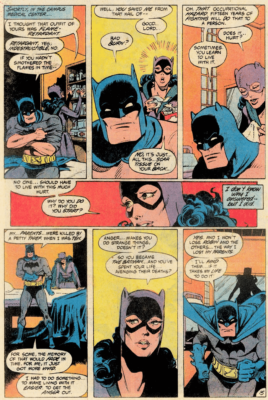
Jim: Yeah. It holds up really, really well. It’s one of my favorites, and your work was great in it. If you didn’t realize, subconsciously, you must have, because you really up the game. It’s a beautifully illustrated piece.
Staton: Well, thank you. It was that whole trying to get the ’40s look, the Earth-2 look. And I had had a chance, with All-Star to kind of develop how I handle those characters. And it just kind of all came together there.
Jim: How much work did you do on Legion of Superheroes? You did at least a short run on that as well. Did you enjoy that at all?
Staton: I never really got a good grip on the Legion. It wasn’t a series that I had followed, so I was kind of trying to figure out who everybody was and what all these costumes were. I never gave the Legion a good run. I didn’t get into the Legion the way I should have. There are stories in there that I think worked well. I’ve always liked the character of Mon-El and, Paul Levitz’ stories about Francis Projectron, Karate Kid. There were some good stories there, but I never quite gave it the interest I should have one. One of these days, in a different reality, I’ll go back, and Paul and I, will do a nice Legion story.
Jim: I remember your Blok, and I thought, well that’s a good Blok. I like that. But it wasn’t your Justice Society, that’s for sure. There was a passion there, that you could see.
Alex: So, Joe, tell us first how you got hooked up with First Comics? What year was that? Was that ’81, or what exact year was that?
Staton: Oh, golly, asking me dates is never good. But I think it was 1980?
Alex: Just straight up, 1980. Okay. So how did that connection happen?
Staton: Well, Mike Gold had been brought in as a PR guy, information guy at DC. He’s out from Chicago, had connections with the other groups out there. One thing led to another, for those connections to be putting together a new comics company in Chicago. I was getting to feeling a little stifled at DC at that point, and Mike asked me, would I like to come off out to Chicago, and be art director, and do a book for a new company out there. And it was the time when, I don’t know, there were Eclipse Comics, I don’t know, various smaller publishers were started in those days.
Alex: Yeah, because the direct market was starting to take hold and there are a lot of independent comics companies, and then a lot of comic stores everywhere. So, it was a boom, economically. Okay. So then, Mike Gold set you up with, and you became art director of First Comics. So, what did that entail, being art director there?
Staton: A little bit of everything. A lot of dealing with the printers, trying to keep various freelancers online. And things with the printers, like we were still printing at Sparta in Illinois. I would fly into St Louis and rent a car, and go out into a corn field where there was this many acres of a building where all the printing was done. And it was an adventure.
[00:10:11]
Staton: I’m just figuring out how everything in comics was done. There was a point at first, where I think I could honestly say I was the only person who could do every step in the production of comic book. From generating an idea to helping unload the trucks out to the store, all of which I had done. I am now a master of many obsolete technologies.
Alex: Oh, that’s cool. It’s funny that you mentioned that because we had Erik Larsen on this show also, and you guys were both at that LA Comic Con. And what’s interesting is, he says the same thing, Mike Gold hooked him up with a lot of work, and that he also can kind of from beginning to end put a comic together. That’s a fascinating connection that you guys have.
You also had E-Man revived at First Comics. How did that get set up there?
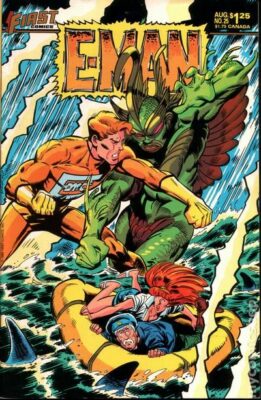
Staton: Eventually, all these people signed up to do books for First were generating their own new characters. And I was working on a new character, kind of a mid-Western superhero. And Mike Gold says, “Why are you trying to do this? We already have a pre-sold character, so why don’t we just do E-Man?” So, it was actually, Mike Gold walked into my office one day and says, “Oh, let’s do that.” So, then they got to work getting the rights from Charlton and undoing a lot of copyright work. And so that’s why we did E-Man.
Alex: Did you, as a creator of E-Man or co-creator of E-Man, were there any royalty issues that had to be worked out during any of this? How did that exactly work?
Staton: First Comics length, there was a copyright lawyer in Chicago by the name of George Bullwinkle, who somehow got all the rights to E-Man straightened out. And the deal was that FIrst would front paying for E-Man, all the expense to get everything from Charlton. But that, my royalties from E-Man would go to cover what they paid. So, we have that deal.
Alex: Like who then, after all that, who owns E-Man at this point?
Staton: Well, it’s kind of a thing that is split between me and a guy named Ken Levin, who’s the lawyer who was involved at First Comics. So, Nick and I could keep on doing new E-Man material, but Ken controls all the media rights to E-Man. So, if there’s ever a E-Man movie. It’d have to be dealt with by Ken.
Alex: Oh, that’s cool. Okay. It’s kind of cool knowing about that stuff. So, then it ran for about 25 issues. It went from ’83 to ’85 as far as cover dates and cover year. And then, Martin Pasko wrote most of the first eight or so issues. And how did you feel he was, as a writer, on the character compared to Nick?
Staton: Well, Marty is another of my buddies, but he and Nick have a different approach. He had a more explicitly satirical take and Nick didn’t deliberately parody things as much. So, it was a different take. Really, E-Man is certainly at home mostly when Nick could still make him.
Alex: Right. That makes sense. You also wrote for the character, a little bit as well, before Nick started writing him, right, again. So, tell us about writing E-Man.
Staton: Well, actually, I’m credited in several issues of E-Man. But the process there was, I would go into the office with three or four ideas, whoever was in the office that day, like Rick Oliver, the assistant editor, was there and Bruce Patterson, and I don’t know, various… We kind of sit around and figure out an idea we could do in the next issue. And I would draw something up…
Actually, Hillary, there she goes again, would do a lot of the dialogue. So, it was just kind of everything was put under my name because I was identified there.
Alex: Oh, that’s cool. So, she did a lot of the actual scripting of that.
Staton: She did. Yeah.
Alex: Yeah. She definitely has a lot of trades, that she’s able to kind of make things happen.
Staton: Yeah. She’s very clever.
Alex: Yeah, that’s really great. Yeah, I had that impression when I met both of you together. That she’s kind of like really organizing a lot of things at the same time. Okay, so you were art director at First Comics from ’80 to ’83, but you kept doing E-Man even past that, right? Because those dates are from ’83 to ’85. Is that correct?
Staton: That’s right. Yeah.
Alex: Yeah. So, a lot of those issues were, while you were not the art director. Right?
Staton: Right. But at that point, Nick had come back and was available to be writing the scripts again. Certainly, that was something I wanted to be around for. I kind of burned out, on staff at First, being a full-time art director, and a full-time artist, and several other things at the same time. Kind of got to be a little bit too much.
[00:15:02]
Alex: So, you were excited, at that point, to just go back to doing art again.
Staton: Right Yeah.
Alex: Yeah. You were ready to go back to that. So, now, were you interacting with guys like Mike Grell, Chaykin, Starlin, around this time?
Staton: Yeah. Well, I certainly would. I was dealing with all those guys there because they were doing the books, and I’d have to talk to them if there’s something needed adjusting or like, “Oh, Howard, you’ve forgotten to draw Flagg’s hip over here, would you…?”
[chuckles]
Staton: I really enjoyed working with Howard. Howard’s my hero.
Alex: Oh, that’s awesome. Yeah. We’ve had him on this show. Fun guy to talk to. And that’s interesting that you both have that Gil Kane lineage. So, when you were seeing pages from him, with his American Flagg! which I think is highly critically regarded, as being in a similar status as the Frank Miller Batman and Alan Moore Watchmen, that he kind of brought that serious storytelling in the 80s. Did you feel like you and Howard had kind of, more of a special bond, than maybe with some of the other people you’d talk to?
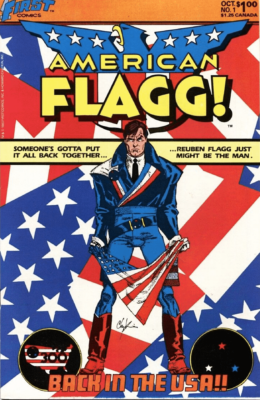
Staton: Yeah, I think so. And certainly, with the Gil Kane background, and just the approach. You know, Howard came out and talked to us at First. We had real nice meetings with Howard and Mike Gold, and the whole crew, when Howard was talking about what he’s going to be doing with Flagg. I think that the name American Flagg came out of one of those meetings.
Alex: Oh really? How fun.
Staton: Yeah.
Jim: Those were great comics, Joe, Sable, the Dreadstar. Those were all really fun to read. How did it go bad?
Staton: Basically, the company was underfunded and we never were able to sell the advertising, we hoped to, to cover the difference. And basically, that we’re just underfunded and couldn’t keep going.
Alex: So now, you also did a story with Marty Pasko for Eclipse’s Destroyer Duck #1 called Gimme My Check. Scott Shaw did the inks… I remember I made a post about this. And there’ve been different renditions of this, Alex Toth – Julius Schwartz story, of Alex not getting his check, throwing him out a window or threatening to, then he got fired. Now, looking back on that artwork, that’s interesting in that the person that looks like… That is that I think represents Toth, kind of looks like Toth. He’s got the Pierre hat too, which is kind of funny because there’s that artist personality, that Toth has of kind of…
Staton: [inaudible 00:17:25].
Alex: Yeah, yeah. That kind of difficult artist… But then there is the Schwartz character, which actually looks more like Robert Kanigher…
Staton: It was my understanding that it was Kanigher.
Alex: I see. So, when you did it, you thought it was actually Kanigher in that story. Is that right?
Staton: That’s the story I was told.
Alex: I got you. That’s why you drew him like Kanigher because you actually thought it was Kanigher. Okay. That’s cool… Yeah, because I made a post about that a couple of years back, and I think that that whole concept of an editor not paying the artists, the artists throwing them out the window, I feel like… Even when Jim and I have interviewed some people, they would say, “Oh yeah, I think…” And it was completely different editors and artists, say, “Oh, I think that artist threw this editor out the window”, when it probably didn’t happen. But it’s such a piece of the folklore of this comics’ history. Why does it resonate so much with a lot of people, that satire? That relationship between artist and the editor.
Staton: It’s one of those stories, if it didn’t happen, it should have.
[chuckles]
Staton: That the people with the money need to be thrown out windows, occasionally.
Alex: [laughter] That’s awesome. Now, before I go to the next section, Jim, did you want to finish up DC?
Jim: Yeah, I do want to finish up DC. Let’s talk about a few things, in terms of that, you did the Millennium Series, and then New Guardians came from that. What was it like doing that? Because that was somewhat controversial, wasn’t it?
Staton: Yeah. I mean, I don’t think I was involved in the controversy just in getting it done. But in terms of getting the book done, weekly or whatever it was, and the book was being rewritten daily, and I was not originally assigned to do the book. I just kind of was thrown into it. And Steve Englehart had a lot of political material he wanted to get into the book, that DC at the last minute, wouldn’t allow him to. So, it was amazing that the book got done at all… I got it in.
Jim: Speaking of Englehart, let’s talk about his run on Green Lantern. What was he like to work with? Did you enjoy working on Englehart scripts?
Staton: I did, very much. I think I’ve said it a couple of times that Steve was not the best writer I ever worked with, but he was definitely the most fun. I never knew where he was going. The stories would just go off in a whole different direction than I was expecting. If you give me a Marv Wolfman Green Lantern script, it’s going to be very well written, and no problem writing. But, after the first couple of pages, I know how it’s going to end. But with Steve, I never knew. I never knew where he was going, what was going to be in the next issue at all because he was always coming…
[00:20:04]
He kind of have had more ideas going on than he could get organized in like any rational reason. So, it was just, it was fun trying to keep up with what he was doing.
Jim: So, it was kind of a surprise when you would turn a page and he had aged Arisia to being a fully grown woman instead of a girl, and they started dating all of a sudden. That had to be a shocker, wasn’t it?
Staton: That was a complete surprise to me. Yes. Right.
Jim: Did you think at all, “I don’t know about this one”?
Staton: [chuckle] I may have had a few hesitations, but I was having so much fun just trying to keep up with him, that it’s not like I would say, “Oh, maybe we should stop and think about this?” No, that never occurred to me. I’m not going to claim that I tried to reign him in or anything. I just tried to keep up.
Jim: With the Guardians, several of those characters were new characters. Were you instrumental in their concepts, in their creation with Englehart? Characters like Chip, obviously, and Arisia. Although I think she had been around a little bit…
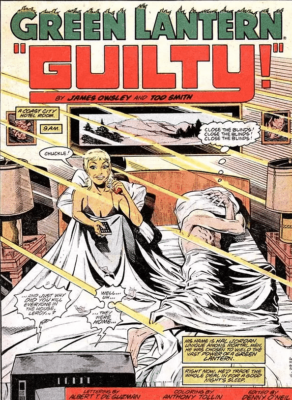
Staton: Arisia, is a Mike Barr character from a miniseries from a few years ago.
Jim: Yeah.
Staton: You know, obviously, I designed a lot of the characters, but I don’t think I had, you know, real input on what the thinking was.
Jim: Did you design Kilowog?
Staton: I did. Yeah.
Jim: He’s got to be one of the most beloved ones you draw, the concept of it. You must get a lot of feedback on Kilowog, don’t you?
Advertisement
Staton: Yeah, well, Kilowog is one of those that everybody loves. I’m more likely to have people ask for drawings of Kilowog in shows than hardly anything else.
Alex: Oh, that’s cool.
Jim: That makes sense to me, because as soon as I saw him on the page, it’s like, well, you just love him. And Englehart knew how to write him, and you know, the catchphrases with the poozer and everything. It was just a perfect character.
Staton: I think so. Steve just gave me a very general outline and said, “This is… It’s a big guy. So, we got to… Big and lovable.” So, we go with that.
Jim: And that was a pretty long run you did with Englehart on Green Lantern, wasn’t it?
Staton: Yeah, I think it was.
Jim: You later did a Batman/Superman Adventures book that you got an Eisner for, correct?
Staton: Right. Yeah, I really like working in the animated style. I never had a run on any of the animated books, but I had a lot of one shots and fill-in, Batman Adventures. Yeah, a lot of that. I really liked that style. It worked very well in that Superman/Batman.
Jim: Were you using, Bruce Timm – Paul Dini model? Or did you hark it back to Alex Toth as well?
Staton: Mostly the current Bruce Timm, but I’m always trying to go back to Alex Toth whenever possible, you know, so… I really liked drawing that style.
Jim: Were there any other books or projects you did at DC during your run there, that you really enjoy doing? I know you did a pretty long run on Superboy. You did a run on Wonder Woman at some point. Did you use the Ross Andru model when you were doing Wonder Woman?
Staton: I think not. I probably should have. I think Ross’ style on Wonder Woman, wasn’t really what they were going for by that time. I guess, I was shooting more for a Dick Giordano look on Wonder Woman. I was kind of an in between style for Wonder Woman. She wasn’t the Andru, she wasn’t George Perez, I was just kind of in there, keeping her going.
You talk about things, that I like to mention I did, a one-shot, Citizen Wayne. Who wrote that?… Mark Waid, I think.
Jim: I remember that.
Staton: It was set on alternate reality, Elseworlds Batman. And I had an amazing inking job, Horacio Ottolini, an Argentinian. It was like a pulp magazine all the way through. I’m really proud of that book. And there was a book about attempting to ban landmines, Suffered the Children, I think was the title. That was written by Denny O’Neil, and Bill Sienkiewicz did beautiful inking. Those are two books… It’s funny, I’d not really that identified with a run on Batman, I’ve done stand-alone Batman material that I think, probably some of my best.
Jim: What about Plastic Man that was in Adventure Comics? Was that intimidating to try to do, follow Jack Cole in anything?
Staton: Well, Jack Cole is one of those guys, I can’t help but follow. It’s like I can’t help but draw them animated style. I can’t help but draw like Jack Cole, as much as I fight it. I love doing the Jack Cole stuff.
And, speaking of working with Marty Pasko, Marty had some of the goofiest of villains for Plastic Man. My favorite was Brickface. There used to be an ad on TV all the time for, some kind of Adobe process where you could have things stuck to the outside of your house and they would draw bricks on it. That was Brickface, and that’s where that villain came from. So those were cool. I liked doing those.
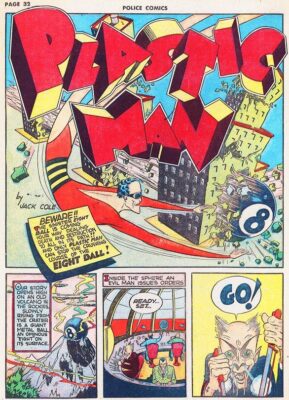
[00:25:01]
Jim: That was a fun series. And this is not DC, but we don’t have it anywhere else. I want to mention that you were actually inking, Elfquest at one point too, for the Pini’s, correct?
Staton: A miniseries, Siege at Blue Mountain.
Jim: When was that?
Staton: Oh golly, when was that?… Maybe in the ’90s. I don’t know. Somewhere in there. I’ve lost track.
Jim: And were you bringing a Wally Wood flavor to it, or what were you doing with it?
Staton: Well, I was trying to be faithful to Wendy, and Wally Wood look really did seem to work well. With the Wally Wood’s slacks in Wendy’s cartoon characters, and everything in cartoon, but solid, like they were real. So, that was Wendy, that was Wally Wood, that was me, I think it worked out pretty well.
Jim: You enjoyed that project too?
Staton: I did. I enjoyed it a lot.
Jim: I liked that a lot. It was a good matchup of people… So, let me ask you a question about DC editorial, during the fairly long period you were there. Did you have relationships with Levitz? Obviously, he brought you on board when he was very junior there, but rose to the top. What was your relationships with the publisher and people in charge?
Staton: Well obviously, with Paul Levitz, he’s still a good buddy. We’ve one of those things that lasts forever. But when I came in, Carmine was still there, I guess Paul had started, but mostly with Carmine. Julie Schwartz took my samples in to Carmine, and Carmine says, “Oh, I don’t need to see these. I know what Wally Wood can do.” So, I took that as a compliment.
Alex: Oh, cool. Yeah.
Staton: I never really had any direct dealings with Jeanette. I saw her occasionally, and say hello. I guess, Dick Giordano was the highest. Other than Paul, I would deal with Dick. And you know, just the regular editors then.
Alex: Did you and Dick have any, like was there like a mutual acknowledged Charlton connection, even though you guys were there at different times?
Staton: Actually, I don’t think so. I never quite… I mean, most everybody clicked very well with Dick, but I never quite, was on the same wavelength. I guess he thought my stuff was too Charlton-ny, a little too goofy for what he was looking for. But we, you know, we worked fine. But I don’t think we ever saw exactly what we were doing.
Alex: Right. And how about, Joe Orlando or Sol Harrison? Any contact with those guys?
Staton: While Sol was still around. He didn’t… He left not too much after I started. And Sol, I’m told, Sol didn’t actually think I should be working, but I never got mad at that person.
Alex: Oh, no. Okay.
[chuckles]
Staton: But I’ve managed to survive Sol, and Joe Orlando was one of those guys who was one of my partisans. Joe was a little bit like Archie. He would get me into things that, he would think I should be doing.
Alex: Oh, that’s awesome.
Staton: Yeah. So, one point, Joe had me do a job for MAD, you know… Then the Power Girl book was, I think that was with Joe. The Huntress, Joe worked on design with us. So yeah. Joe and I were buddies.
Alex: Well, Gaspar lettered over you quite a bit. Did you have any contact with him? Did you like his lettering? Do you have a tendency to like one person’s lettering more than another’s?
Staton: I don’t think I’ve ever met Gaspar. But I certainly really liked his lettering a lot. At first, I always loved Ken Bruzenak’s lettering. He lettered American Flagg!. He did Hulk. His lettering was an amazing part of the art. Lettering’s important.
Alex: Yeah. Now, before we get to Dick Tracy, you did some other crime strips prior to that assignment. In the early ’90s, you did Mickey Spillane’s Mike Danger Sunday strip, with Max Allan Collins. What was that like?
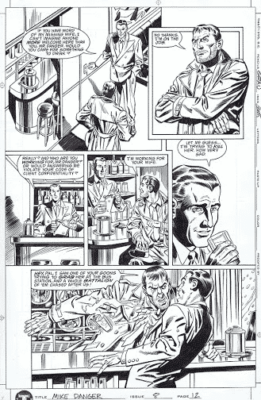
Staton: It was fun. Chris Mills, was an editor, what was that Tekno? They were putting it together. It was as close to Dick Tracy as I thought I was ever going to get.
Alex: Are you a fan of Mickey Spillane?
Staton: Not specifically. I’m more of a fan of Raymond Chandler…
Jim: Yes.
Alex: There you go.
Jim: Me too.
Staton: And more, Dashiell Hammett, more sophisticated versions of the detectives.
Alex: Yeah, yeah, yeah. Steranko, we had him on the show. He’s a big fan of Chandler, which obviously, we know that because he did a Chandler graphic novel. And actually, he told me that he stood in front of Raymond Chandler’s house and took a picture in front of his house. He was that big of a fan, which he was like, “Take a picture of me, in front of Raymond Chandler’s house.” So that’s a fun story.
Okay, so those are your favorite crime writers, did you ever look at, Dashiell Hammett and Alex Raymond’s Secret Agent X-9? Did you ever check those out?
Staton: Oh yeah. Yeah. I love that stuff.
Alex: Okay. Do you enjoy crime comics in general?
Staton: Yeah, actually, given my druthers, I think I would do crime comics rather than anything else.
Alex: Rather than anything else. Yeah, because you were a sci-fi fan just in general, and then you’ve done quite a bit of superhero stuff. It seems like you have a lot of fun with the crime comics.
[00:30:00]
Staton: I do. Yeah. I go back to Mr. District Attorney, so I like the crime stuff.
Alex: That’s cool. Does that involve like crime TV shows and things like that too?
Staton: Yeah.
Alex: Oh, that’s awesome. So then, now this is a funny… The most successful crime solver character of all time, you also did Scooby-Doo, and that’s funny. You did about a hundred issues of Scooby-Doo starting in 2000. How did that come about?
Staton: I had been doing… What was I doing before that? I guess, Guy Gardner. I lost Guy. Guy was, being changed. And I was walking down the hall, and, Marty Pasko was the head of special projects and they were taking care of the Scooby-Doo books and Bronwyn Taggart was the editor.
Marty says, “Hey, you want to do a couple of Scooby-Doo issues?” So, I started working with Bronwyn. And I love Bronwyn, she understood my humor. We’d hit it off. And everybody was kind of doing a Scooby-Doo issue here and there. Then she said, “This is too much trouble. Why don’t you just do the book?” And that happened. So, I wound up drawing Scooby-Doo for 13 years.
Alex: Yeah. That’s huge.
Staton: I was perfectly happy just with Scooby and the Mystery Machine, and the whole thing.
Alex: Yeah, because you can do cartoon, and I guess that explains why you like a Plastic Man and that he’s kind of a mixture, but he’s kind of a cartoon character at the same time as the superhero genre. So that’s kind of an interesting…
Staton: Plastic Man is, you know, he’s kind of a basis for E-Man, so it all comes together.
Alex: Yeah, because E-Man can manipulate his body and do all sorts of weird things with it as well. That makes sense. That’s a funny connection there. So then, now you also did a crime strip called Femme Noir? What was that about?
Staton: That was with Chris Mills, his own character. Our original idea of what Femme Noir was that she was going to be a female version of the Spirit. She’d wear a blue raincoat, another character in a hat. I like drawing hats. Chris was developing a whole city to surround her, and some of these were just a very traditional pulp type horror. Well actually, some of them was horror, some of it was science fiction, but it was all in a crime tradition. Maybe one of these days we’ll do some more Femme Noir. I really liked that character.
Alex: Uh-hmm… In 2011, you took over the art on the Dick Tracy strip. Was that a dream come true for you?
Staton: It was one of those things that I’d always been wanting to do. I had always tried out for Tracy. And, it just kind of fell into place because, Mike Curtis and I, great Tracy fans. At the time, it was kind of generally understood, you could do like tribute versions of copyright characters, and there’d be no trouble as long as you weren’t really infringing. I’ve since learned this is not true. You can be sent away for doing this. And we were sending it to the Trib, and the Trib was realizing that, we were doing our own Dick Tracy strip online, just for fun.
Staton: At that point, Dick Locher, who’ve been doing the strip for a very long time, finally decided to retire and they said, “Well, there are these guys, who we should have sent to jail. Why don’t we just hire them?” So that’s how that became. Now, they called Mike and says, “You guys want to take over the strip?” And he says, “Well, I’ll ask Joe…” and “Yeah, we’ll do it.”
Alex: How fun…
Staton: Either people call out of the blue with things or things just fall into place. Things I tried to do, you know, don’t quite work. But things that just fall in, those turn out pretty good.
Alex: Yeah. So then, did you go back and read some of the 1930s Chester Gould stuff as well, or had you already done that?
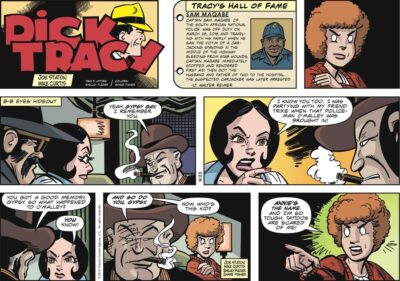
Staton: I’d read a lot of it. At this point, Mike has actually read all of it, the IDW reprints. They send them to the Trib, Trib sends them to us. So, we have good reference. We can go checking back. We bring back a lot of the old characters, do a lot of our own, but a lot of the old characters and yeah. It’s a tradition. We’re keeping it going.
Alex: Oh, how fun. And you actually received Harvey awards for Dick Tracy for three years, 2013, 2014, 2015. So, you’re receiving a lot of, critical as well as fan praise. How does that feel? Were you surprised to get your first Harvey award for that? What was your thinking on this?
Staton: We were surprised, yeah. Very, very pleased to see that something we’d always wanted to do is being appreciated. So, we’re surprised and we’re very happy that it’s getting a good reception.
Alex: Yeah. I was looking at some of the free samples you’re giving out at the convention, and I was really impressed because it feels like it’s continuing that Chester Gould vibe. So, you’re really kind of summoning this force here. So how long do you want to stay on this strip?
Staton: It depends on the week end. Sometimes, I’ll just be around till Tracy’s a hundred. Sometimes, I figure, I’ll be around till the end of the week. I can’t give you a definite answer there. Depends on how tired I am at the moment.
[00:35:09]
Alex: Nice.
Staton: It’s a lot of work.
Alex: Yeah, it’s a lot of work for sure. All right, Jim.
Jim: Okay. Just a couple of random closing questions and things. I’m going to assume when I ask you who your favorite collaborator was that you’re going to say your wife, because the two of you do comics together, things for the Children’s Hospitals, and things like that. Tell us about that a little bit, because that’s awesome.
Staton: The, Boston Children’s Hospital, it turns out that the head of gastroenterology is a Scooby-Doo fan. His son was very young at the time, and he was buying him Scooby-Doo comics. He he sent out a letter to DC, Scooby fan letter. And I sent him a drawing and we talked a bit, compared notes. And as a comics fan, he had always wanted to use comics to explain diseases and dealing with hospitals, and things like that. He realized, when he found out that I could draw this, and my wife, Hillary is a writer. He realized; he’d found his team.
Our first book was about Crohn’s and colitis, and we dealt with the national group and went to camps for kids with the diseases, and it did all kinds of research. It worked out well. We actually did a book about a little kid who has Crohn’s, and how he deals with the whole thing. And we did a couple of more books after that. We’re actually doing another one at the moment. It turned out well, you never know when you’re going to find a comics fan in a useful position.
Jim: You took a hiatus from Dick Tracy, a couple of years ago. Was that when you were working on the Ayn Rand Anthem book? Or was that not connected?
Staton: The Ayn Rand was before that.
Jim: Before that. Okay.
Staton: I took a…
Jim: How did that come into being? It seems like an odd project for you.
Staton: It is. I occasionally work with, Charlie Santino, who’s a packager and a writer. And it was Charlie, yeah, he put it all together. And I’m also a fan of Classics Illustrated. I first did Classics; I did A Christmas Carol. And so, it’s not that I was that interested in this philosophy or anything, but it was a book to be adapted to become a comic. That’s how I got into it. Some of Ayn Rand’s science, and it needs to be explained. So, Charlie did more designs of how the electrical stuff is actually done. So, it was fun. We did it as a YA romance? It’s about two cute kids who want to go out in the woods and start their own civilization. That was fun. I think it was definitely fun.
Jim: And what did you do during your hiatus? Why did you take the time off?
Staton: From Tracy?
Jim: Yeah.
Staton: Well, occasionally, I’ll just want a break and, we’ll get somebody to do a Minit Mystery, which there’s a tradition of short mysteries in the Dick Tracy comic books from Harvey, from the 50s and 60s. So, Rick Burchett did a really great one, Charles Ettinger also. It’s fun to see how different people will handle Tracy, without having to turn the strip over to somebody else. It gives a break and it lets us see what other people would do.
Advertisement
Jim: And Rick Burchett, he was an inker for you when you first did the E-Man.
Staton: That’s right.
Alex: I remember that because he was a good match with you. Who are the inkers that you thought that you enjoyed seeing their inks on your work?
Staton: Well obviously, Rick, and Bill Sienkiewicz, Horacio Ottolini, Bruce Patterson. I always liked Bruce’s inks on Green Lantern. Yeah, there’s been several good ones.
Jim: Joe for me, this has been a real pleasure. You’re a favorite of mine. And I wanted to thank you. I’m going to turn you over to Alex to close out.
Staton: Well, thank you.
Alex: Yeah. Thanks, so much Joe. It seems from career you’ve been a fan of comics from the beginning. You set out to do it. And what it looks like is just through patience and hard work, you’ve managed to hit all sorts of aspects of the comic industry. Hitting up all sorts of characters, creating new characters, co-creating new characters, even having production experience. Looking back, it’s a huge career, and we’re excited to see more of your work. And it seems like sometimes some artists, they kind of peter out, but you just keep going. I’m just really impressed. You’re just this really, hardworking, creative dynamo. Thanks so much for joining us today.
Staton: Well, thank you. I appreciate it.
© 2020 Comic Book Historians
